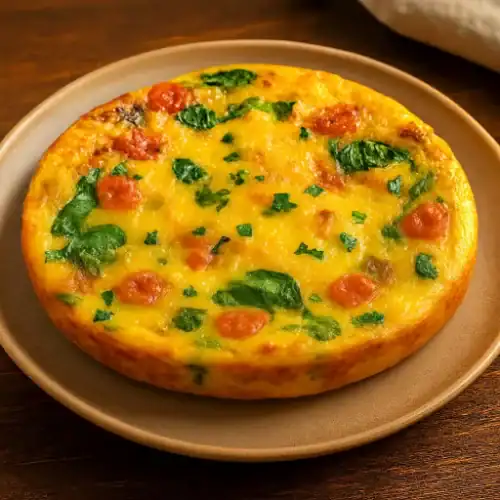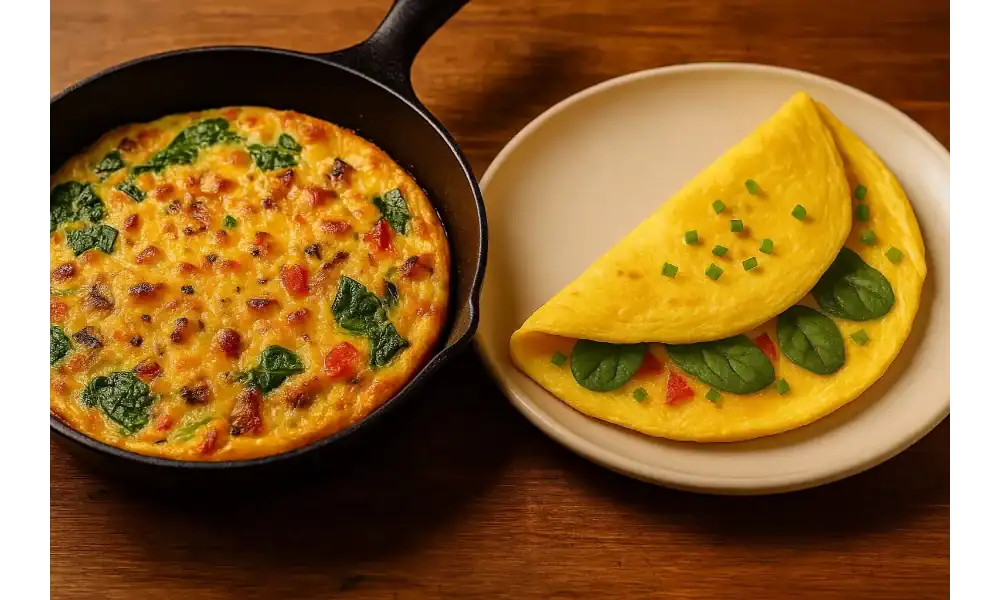Introduction
Egg-based breakfasts are a favorite around the world. They’re quick, healthy, and full of protein. Two popular choices are the frittata and the omelet. While they look similar, they are not the same.
Many people mix them up. That’s because both dishes use eggs and often include cheese, vegetables, or meat. But they differ in texture, cooking style, and how you serve them.
In this post, we’ll break down the difference between frittata and omelet. You’ll learn how each one is made, when to pick one over the other, and what makes them unique.
Frittata vs omelet—which one is better for your breakfast? That depends on your taste and schedule.
By the end, you’ll know exactly which dish fits your morning mood.
For more similar recipes try our:
- How to Make the Perfect Apple Frittata – Sweet and Savory Brunch Delight
- 10 Easy Veggie Omelette Recipes for a Healthy Start to Your Day
- 10 Best Omelet Fillings for a Delicious and Satisfying Breakfast
- Easy Vegan Omelette Without Eggs – Perfect for Breakfast or Brunch
What Is a Frittata?
Definition & Origin
A frittata is a classic Italian egg dish. People often call it a “crustless quiche.” Unlike a quiche, it doesn’t need a pie crust. It’s simple, filling, and great for any meal—breakfast, lunch, or dinner.
Cooking Method
You cook a frittata slowly. First, pour the egg mixture into a pan. Then, cook it on the stovetop until the edges set. After that, move it to the oven to finish. This method gives it a soft and even texture.
Texture
Frittatas are thick and firm. The inside feels creamy, almost like custard. It holds together well, making it easy to slice and serve.
Common Fillings
You can mix the fillings right into the eggs. Use cheese, vegetables, or cooked meats. Some favorites are spinach, bell peppers, onions, ham, and cheddar. The options are endless.
Serving Style
Slice your frittata like a pie. You can serve it hot, warm, or even cold. It tastes great fresh or as leftovers the next day. Perfect for meal prep or brunch gatherings.
Frittatas are tasty, flexible, and protein-packed. If you need a make-ahead breakfast, the frittata is a smart choice.
What Is an Omelet?
Definition & Origin
An omelet is a classic French-style egg dish. It’s famous for its smooth, folded shape. Unlike a frittata, it cooks fast and folds around the fillings. Many people enjoy it as a quick and warm breakfast.
Cooking Method
You cook an omelet quickly on the stovetop. Pour the eggs into a hot pan. Stir gently, then let them set. There’s no need to use an oven. This makes omelets perfect for busy mornings.
Texture
Omelets are soft and fluffy. The center stays a little creamy and moist. They feel light and melt in your mouth. That’s what makes them different from thick frittatas.
Common Fillings
Fillings go in after the eggs set. Use cheese, ham, herbs, or veggies. Try mushrooms, fresh spinach, or green onions. You can mix and match based on what you like.
Serving Style
Fold the omelet in half or in thirds. Then serve it hot, straight from the pan. It’s best when fresh and warm.
The difference between omelet and frittata starts here. Omelets are fast, light, and great for one person. If you want a quick, protein-packed start to your day, the omelet is a top pick.
Key Differences Between Frittata and Omelet

Cooking Time
A frittata cooks slowly. You start it on the stovetop and finish it in the oven. In contrast, an omelet cooks fast on the stovetop. If you want a quick breakfast, go for an omelet. For a slower, richer dish, choose a frittata.
Filling Integration
In a frittata, you mix the fillings directly into the eggs. Everything cooks together. On the other hand, omelet fillings are added later, once the eggs begin to set. This makes each bite of a frittata more blended, while omelets offer layered textures.
Thickness
Frittatas are thick and hold their shape well. They look more like a pie or casserole. Omelets are thin and delicate, with a soft fold. If you prefer a hearty slice, choose a frittata. If you want something light, an omelet is best.
Portion & Sharing
A frittata can serve multiple people. It’s great for families or brunch with friends. But an omelet is usually a single portion, perfect for a personal breakfast or lunch.
Tools Used
You need an oven-safe skillet for frittatas. This lets you move it from stove to oven. For omelets, a nonstick pan works best. It helps the eggs cook fast and fold cleanly.
When comparing a frittata vs omelet, these differences matter. Each one has its place depending on time, taste, and tools.
When to Choose Frittata or Omelet
For Meal Prep
A frittata is perfect for batch-cooking. You can make it ahead, slice it, and store it in the fridge. It stays tasty for days. This makes it a smart choice for busy mornings.
For Quick Meals
An omelet is faster to make. It takes just a few minutes from start to finish. That’s why it’s ideal for weekday mornings when time is tight.
For Special Brunch
A frittata looks beautiful on the table. It’s thick, golden, and easy to slice. This makes it great for sharing during a weekend brunch or family meal.
For Customization
Omelets are easy to personalize. You can add different fillings to each one. That’s helpful when everyone wants something different. It’s also fun to try new combos.
For Dietary Goals
You can make a low-carb, high-protein frittata with ease. Just skip the starchy fillings and use eggs, veggies, and lean meats. It’s a solid choice for keto or high-protein diets.
When choosing between a frittata or omelet, think about your time, your goals, and who you’re feeding. Each dish has its moment to shine.
Nutritional and Dietary Considerations

Calories and Protein
Both dishes are packed with protein. A standard omelet has fewer calories because it’s lighter and thinner. A frittata has more calories due to added fillings and larger portions. Still, both give you good protein for energy.
Low-Carb/Keto Options
You can enjoy either dish on a low-carb or keto diet. Just skip potatoes or bread. Use eggs, cheese, and low-carb veggies like spinach or zucchini. That keeps your breakfast high in protein and low in carbs.
Dairy-Free and Vegetarian Variants
For a dairy-free frittata or omelet, avoid cheese and use plant-based milk if needed. Want it vegetarian? Load up on mushrooms, peppers, or tomatoes. Both recipes adapt easily to these diets.
Gluten-Free Status
Frittatas and omelets are naturally gluten-free. Just avoid adding flour or breadcrumbs. This makes them safe choices for anyone with gluten sensitivity.
Healthy Add-Ins
Boost nutrition with smart add-ins. Try spinach, tomatoes, fresh herbs, or lean meats like turkey. These healthy omelet and frittata fillings add flavor without extra calories.
If you’re watching your diet, both the frittata and omelet are great picks. Just choose the right ingredients to meet your needs.
Homemade Spinach Tomato Frittata

Homemade Spinach Tomato Frittata
Ingredients
Method
- Preheat oven to 375°F (190°C).
- Whisk eggs, milk, salt, and pepper in a large bowl.
- Heat olive oil in an oven-safe skillet over medium heat.
- Sauté spinach for 1–2 minutes until wilted.
- Pour egg mixture into skillet. Add tomatoes and cheese on top.
- Cook on stove for 2–3 minutes until edges start to set.
- Transfer skillet to oven. Bake for 10–12 minutes or until center is set.
- Let it cool slightly, then slice and serve.
FAQs
1. What is the main difference between a frittata and an omelet?
A frittata is baked and thick. An omelet is cooked fast on the stovetop and folded.
2. Which is healthier—frittata or omelet?
Both can be healthy. It depends on your fillings. Use lean meats and veggies for fewer calories.
3. Can I make a frittata without an oven?
Yes. You can cook it fully on the stovetop using low heat and a lid.
4. Can both frittatas and omelets be made dairy-free?
Yes. Just skip the cheese or use plant-based alternatives.
5. Do frittatas have to be thick?
Usually, yes. Their thickness gives them a firm texture and pie-like look.
Conclusion
Now you know the key differences between a frittata and an omelet. Frittatas are thick, baked, and great for sharing. Omelets are soft, fast, and perfect for a quick meal. Both are tasty, healthy, and full of protein.
You don’t have to choose just one. Try both and see which one fits your mood, time, or diet. Make a frittata for weekend brunch. Whip up an omelet on a busy morning.
So, what’s your pick?
Team Frittata or Team Omelet?
Tell us your favorite breakfast go-to in the comments!
For more recipes, try our:
- 10 Delicious Ricotta Breakfast Recipes to Start Your Day Right
- How to Make the Best Philly Cheesesteak at Home (Authentic & Easy)
- 10 Healthy Asparagus Recipes You’ll Want to Make All Spring
- How to Make the Best Chicken Kebabs at Home – Quick and Simple
- How to Make Perfect Mediterranean Roasted Asparagus

